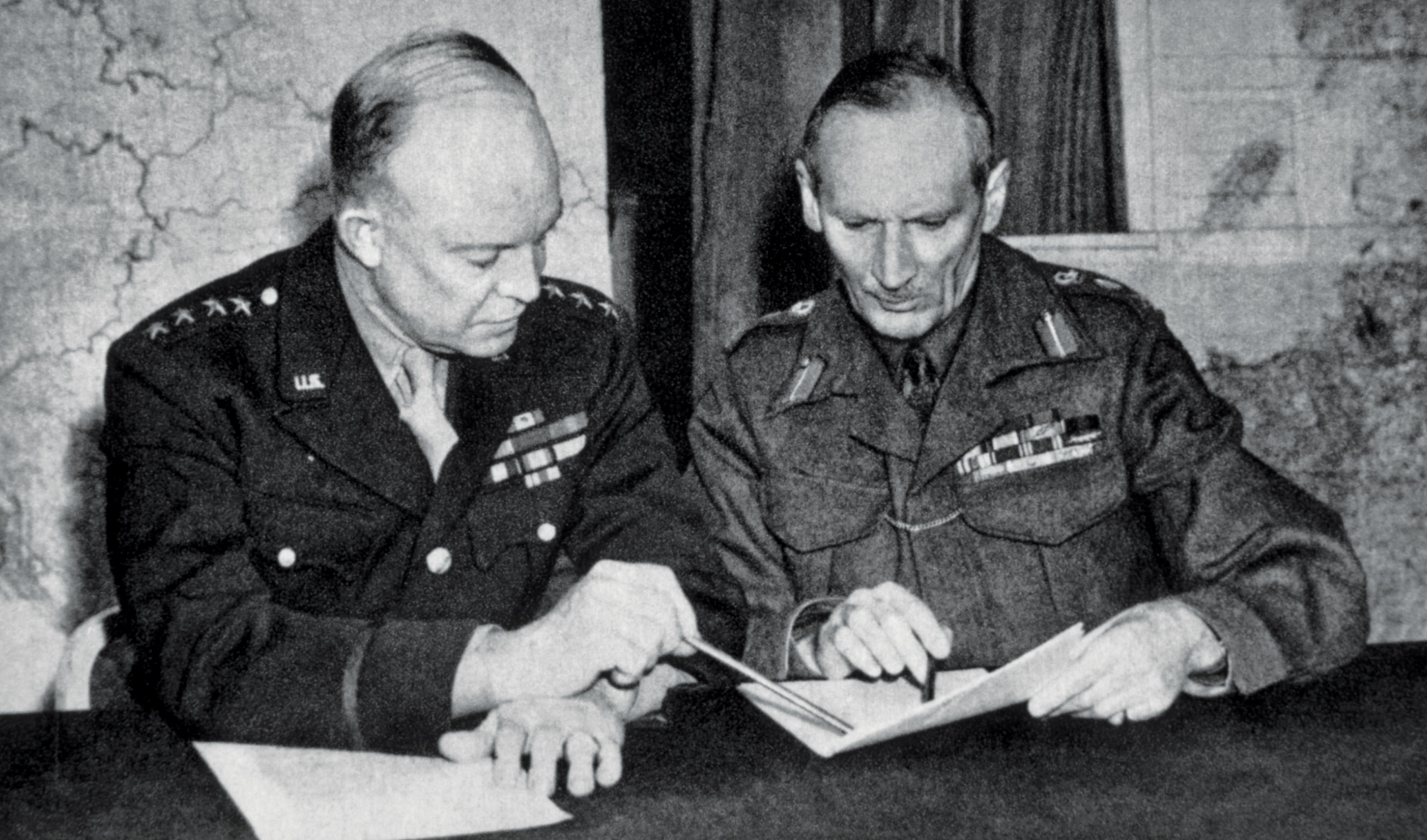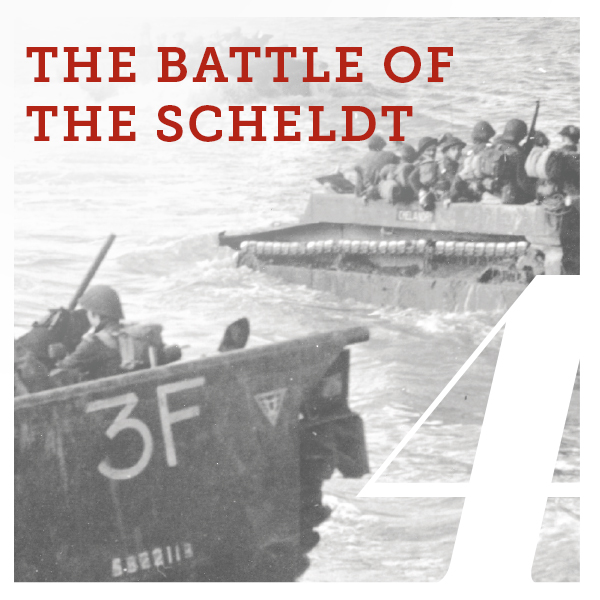

It does not require hindsight to criticize Montgomery’s strategy in September 1944. As Allied supply lines stretched farther and farther from the Normandy beaches, the problem of supplying the advancing troops was rapidly becoming unmanageable. With the French rail system still in chaos from bombing, virtually all supplies had to be brought forward by truck and there were simply not enough trucks. So, when the 11th British Armoured Division and the Belgian resistance gained control of Antwerp, Belgium, the largest port in Europe, on Sept. 4, 1944, the strategic imperative was obvious—clear the approaches from the North Sea up the Scheldt River estuary through the Netherlands to Antwerp.
Antwerp is 100 kilometres from the sea and it depends on free ship passage up the river. German defences, built as part of the Atlantic Wall, controlled access to the river—especially the heavy guns on the Dutch island of Walcheren. On Sept. 3, British naval commander-in-chief, Admiral Bertram Ramsay, reminded everyone that the coastal batteries had to be captured before Antwerp could be used. Montgomery chose to ignore this warning and remained committed to his concept of a “single thrust” to cross the Rhine River and reach Berlin.
This was a very attractive idea, raising the possibility of ending the war in 1944, but was it a viable plan or a fantasy based on the belief that German resistance had collapsed?
Between Sept. 4 and 10, Montgomery searched for ways to achieve his goal while ignoring the problem of Antwerp. His proposed solution was Operation Market Garden, a plan to use three available airborne divisions to secure a series of canals and river crossings, allowing ground units to consolidate north of Arnhem, Netherlands. This “airborne carpet” would permit Britain’s XXX Corps to advance into Germany. Supplies for the single thrust would come from “one good Pas-de-Calais port” captured by First Canadian Army.
Montgomery later claimed that Market Garden was “90 per cent successful,” despite the destruction of 1st British Airborne Division, the failure of ground units to cross the Rhine, and the subsequent struggle to defend the salient the operation created. He acknowledged that the delay in opening Antwerp was a mistake, but he had thought the Canadians could do it on their own.
Alternative courses of action have never been examined in detail but the basic elements are clear. Instead of ordering XXX Corps to halt at Antwerp and then turn east, the Corps could have advanced west to the estuary to join forces with airborne troops landing on Walcheren Island. XII British Corps, then approaching Ghent, together with the 4th Canadian and 1st Polish Armoured divisions, had more than adequate resources to overcome the German naval troops garrisoning the coastal fortifications while blocking the advance of the remaining elements of Germany’s 15th Army attempting to reach Walcheren.
Crucial to this scenario would have been the employment of tactical air power in close support of operations in the Scheldt estuary and a willingness to use airborne troops in a coastal region. Antwerp could have been open by early October, establishing the logistical base for the invasion of Germany.

Operation Market Garden, the uncompleted Allied operation to try to cross the Rhine River in September 1944, held enormous implications for First Canadian Army. Canadian war cemeteries—at Calais in France, Adegem in Belgium and Bergen op Zoom in the Netherlands—speak to the heavy cost borne by the Canadians in the fall of 1944. Even so, these casualties should not blind us to the real promise of Market Garden in September 1944.
The many critics of Market Garden reinforce the view that the real priority in September 1944 should have been to open shipping into Antwerp, Belgium, the vital port at the tidal mouth of the Scheldt River. British historian John Buckley maintains that Market Garden was a “conceptual failure” for three reasons: it disregarded Germany’s ability to strengthen its defences; it asked the British Army to ignore its artillery-based set-piece doctrine and make a 90-kilometre dash through enemy lines; and it overestimated the effectiveness of airborne operations.
Such judgements are best understood in hindsight, but in early September 1944, the Allied armies had burst out of Normandy, leaving the remnants of two German armies in their wake. The long anticipated German defences at the Seine and Somme rivers never materialized. Second British Army’s rapid dash found it in Antwerp by Sept. 3. Much to the delight of French, Belgian and Dutch civilians, Germany’s 15th Army seemed to be in full retreat. If ever there was a time for bold strokes, this was it.
Certainly, Montgomery’s plan was risky. Dropping British and Polish airborne troops near Arnhem, Netherlands, posed an imposing logistical challenge. As did the plan to punch elements of Britain’s XXX Corps through a corridor held open by American airborne troops at crucial river crossings right up to the Rhine. Still, even the slightest chance of crossing the Rhine in 1944 was too tempting to pass up. Although he knew the plan would likely delay opening Antwerp, Supreme Allied Commander Dwight D. Eisenhower approved Market Garden on Sept. 10. The Scheldt would have to wait.
The first airdrops started exactly a week later, on Sept. 17, 1944, the same day 3rd Canadian Division led Operation Wellhit on the French port of Boulogne-sur-Mer. While the Canadians continued fighting north along the French coast, Market Garden began to lose momentum. As the remains of 1st British Airborne Division evacuated back from the Rhine on Sept. 26, Market Garden was over. It had failed and dashed Allied hopes of finishing the war by Christmas, but it was worth the risk. To have shortened the war in Europe, even by a few months, would have saved countless lives.
Montgomery later admitted that he was wrong to assume the Canadians could open the approaches to Antwerp while his forces tried to reach Germany. But his timing was off. The Canadians began fighting around Antwerp in early October, after Market Garden had ended. So, our original question prompts another: Why did it take to the middle of October for Montgomery to support the embattled Canadians and make Antwerp a priority?
Advertisement













